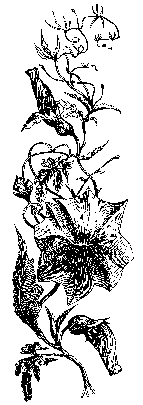


is for Dill–
it’s not just for
pickles anymore
This common garden herb is used for both its seed and its fragrant leaf. Everyone is familiar with the dill pickle, which is usually a cucumber left whole or cut into spears, chunks, or slices, and flavored with vinegar, salt, dill, spices, and sometimes garlic. And even though a pickle can be anything from a string bean to a peach, those long, crunchy cucumber spears will inevitably be flavored with dill seed. In cook’s jargon, pickling is actually a process, and there is more than one way to fix your pickle. What we commonly call pickles are technically pickled cucumbers. You can even pickle wood, such as for paneling or flooring, with calcium carbonate or lime.
This Fish Is Delish
If you haven’t tried fresh dill weed, as the leaf is often called, you are in for a real treat. This lovely herb is used extensively in Scandinavian, Russian, and Eastern European cooking. And while the leaf may look delicate, it adds a lot of flavor. Use fresh dill weed in egg dishes, either as an edible garnish or as small amounts minced into the dish itself. It is the quintessential flavoring to a steaming bowl of new potatoes; simply sprinkle it on fresh or dollop with a generous amount of dill blended with soft butter, which you can use to season all types of fresh vegetables or even fish. Use the leafy fronds to stuff whole fish for grilling. Dill weed is an essential ingredient in a popular Swedish preparation made with fresh salmon called gravlax. The following recipe is similar to one found in The Herbal Palate Cookbook by Maggie Oster and Sal Gilbertie. Some recipes include thinly sliced lemon and red onion along with the herbs; I don’t care for the onion, but do what you like best. Please note that Atlantic salmon is not the same as Pacific salmon, but use whichever you prefer and can procure, as long as it is very fresh. Yes, four pounds of salmon can be pretty spendy, but it makes a lot; reduce the recipe by half and it still tastes the same—delicious!

Gravlax with Dill and Spearmint
¼ cup kosher salt
¼ cup sugar
2 ultra-fresh salmon fillets with skin, similarly sized at about 2 pounds each
1 tablespoon whole peppercorns
½ cup minced fresh dill leaves
¼ cup minced fresh spearmint leaves
Combine the salt and sugar in a bowl. Carefully remove any bones from the fish. On the flesh side, score each fillet 3 or 4 times diagonally. Sprinkle the salt–sugar blend on all sides of the fish, then place one fillet skin-side down on a large piece of plastic wrap. Sprinkle half the peppercorns on the fish, then layer on the fresh herbs. Sprinkle with the rest of the peppercorns, then match the other fillet flesh-side down onto the herbs, atop the other piece. Wrap tightly in the plastic wrap.
Next, place the wrapped salmon in a large glass baking dish and cover with another heavy, flat dish or pan, and weigh this down with a (towel-wrapped) brick or something heavy to evenly press on the fillets. Refrigerate, turning the fish package every 12 hours.
After 48 hours, open the package and drain any liquid that has accumulated. Gently scrape off the herb blend and peppercorns and discard. Carefully fillet the skin away from the flesh.
To serve, place on a cutting board and thinly slice the salmon at an angle with a long, sharp knife. Small rounds of rye or wheat bread and sliced cucumber make this dish complete, with perhaps a tiny dab of sour cream.
How Did They Know?
The word dill comes from the Norwegian dilla, meaning “to lull,” and indeed, a mild tea made from the seeds is a good remedy for baby’s colic and is said to help bring on mother’s milk. Boil 1 pint (2 cups) water, remove from heat, stir in 1 teaspoon dill seed, then cover and steep for 5 minutes; strain and serve warm, up to 2 cups a day for mother and 2 small spoonfuls every hour for baby. You can also gently warm the seeds in milk for baby.
Chewing on dill seed is said to be a remedy for hiccups. The lulling quality of dill must be one of the reasons why it is often used in sleep pillows—you know, those little pillows stuffed with magical herbs that you tuck under your regular pillow to lull you to sleep (or, in the case of dream pillows, to inspire subtle relaxation and psychic awareness—see “X is for Xanadu,” page 294). I love how folklore follows utility—or is it the other way around…?
Take It Outside
It’s easy to grow dill. If you have the garden space, you can successively plant every two weeks starting in May until the end of June for fresh dill all summer. It is a tall plant, from two to three feet, and prolific, so take that into consideration. Be sure to save some seed for planting next year; before they are fully ripe, cut the stem at least a foot below the seed head, and tie several stems into a bunch to hang and dry in a dark, airy place. It makes a good companion plant for cole crops–cabbage, broccoli, and so on—while growing dill with carrots, parsnips, or other plants of the parsley family (to which dill belongs) is discouraged. If you find that you have extra dill fronds, you can use them in floral arrangements; they look especially nice with carnations.